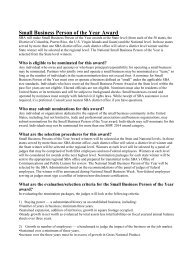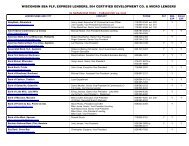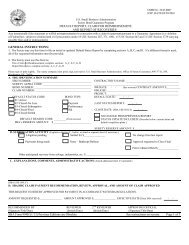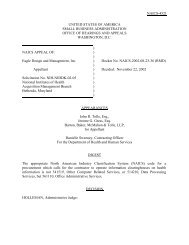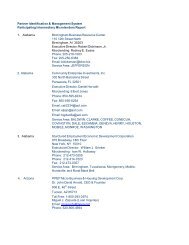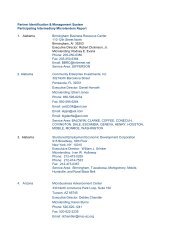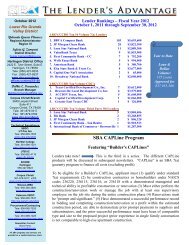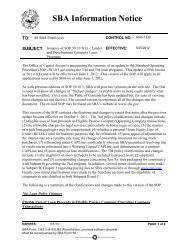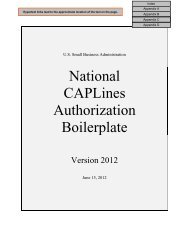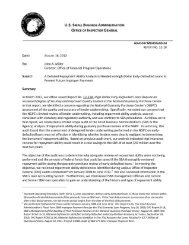Oklahoma Small Business Resource Guide - SBA
Oklahoma Small Business Resource Guide - SBA
Oklahoma Small Business Resource Guide - SBA
You also want an ePaper? Increase the reach of your titles
YUMPU automatically turns print PDFs into web optimized ePapers that Google loves.
ADDITIONAL RESOURCES<br />
Federal Registration of Trademarks<br />
and Copyrights<br />
Trademarks or service marks are<br />
words, phrases, symbols, designs or<br />
combinations thereof that identify<br />
and distinguish the source of goods.<br />
Trademarks may be registered at both<br />
the state and federal level. To register a<br />
federal trademark, contact:<br />
U.S. Patent and Trademark Office:<br />
P.O. Box 1450<br />
Alexandria, VA 22313-1450<br />
800-786-9199<br />
www.uspto.gov/<br />
Trademark Information Hotline<br />
703-308-9000<br />
BUSINESS ORGANIZATION:<br />
Choosing Your <strong>Business</strong> Structure<br />
There are many forms of legal<br />
structure you may choose for your<br />
business. Each legal structure offers<br />
organizational options with different<br />
tax and liability issues. We suggest you<br />
research each legal structure thoroughly<br />
and consult a tax accountant and/or<br />
attorney prior to making your decision.<br />
The most common organizational<br />
structures are sole proprietorships,<br />
general and limited partnerships,<br />
“C” and “S” corporations and limited<br />
liability companies.<br />
Each structure offers unique tax and<br />
liability benefits. If you’re uncertain<br />
which business format is right for you,<br />
you may want to discuss options with a<br />
business counselor or attorney.<br />
Sole Proprietorship<br />
One person operating a business as<br />
an individual is a sole proprietorship.<br />
It’s the most common form of business<br />
organization. Profits are taxed as<br />
income to the owner personally. The<br />
personal tax rate is usually lower than<br />
the corporate tax rate. The owner<br />
has complete control of the business,<br />
but faces unlimited liability for its<br />
debts. There is very little government<br />
regulation or reporting required with<br />
this business structure.<br />
General Partnership<br />
A partnership exists when two or<br />
more persons join together in the<br />
operation and management of a<br />
business. Partnerships are subject<br />
42 — <strong>Small</strong> <strong>Business</strong> <strong>Resource</strong> OKLAHOMA<br />
STATE REGISTRATION<br />
OF A TRADEMARK<br />
Trademarks and service marks may<br />
be registered in a state.<br />
Caution: Federally registered<br />
trademarks may conflict with and<br />
supersede state registered business and<br />
product names.<br />
Patents<br />
A patent is the grant of a property<br />
right to the inventor by the U.S. Patent<br />
and Trademark Office. It provides the<br />
owner with the right to exclude others<br />
from making, using, offering for sale or<br />
selling the patented item in the United<br />
States.<br />
Additional information is provided in<br />
the publications, General Information<br />
Concerning Patents and other<br />
to relatively little regulation and are<br />
fairly easy to establish. A formal<br />
partnership agreement is recommended<br />
to address potential conflicts such as:<br />
who will be responsible for performing<br />
each task; what, if any, consultation<br />
is needed between partners before<br />
major decisions, and what happens<br />
when a partner dies. Under a general<br />
partnership each partner is liable for all<br />
debts of the business. Profits are taxed<br />
as income to the partners based on their<br />
ownership percentage.<br />
Limited Partnership<br />
Like a general partnership, a<br />
limited partnership is established by<br />
an agreement between two or more<br />
persons. However, there are two types<br />
of partners.<br />
• A general partner has greater control<br />
in some aspects of the partnership.<br />
For example, only a general partner<br />
can decide to dissolve the partnership.<br />
General partners have no limits on the<br />
dividends they can receive from profit<br />
so they incur unlimited liability.<br />
• Limited partners can only receive<br />
a share of profits based on the<br />
proportional amount on their<br />
investment, and liability is similarly<br />
limited in proportion to their<br />
investment.<br />
“C” Corporation<br />
A “C” corporation is a legal entity<br />
created under state law by the filing of<br />
articles of incorporation. A corporation<br />
is a separate entity having its own<br />
rights, privileges and liabilities, apart<br />
publications distributed through the<br />
U.S. Patent and Trademark Office. For<br />
more information, contact the:<br />
U.S. Patent and Trademark Office<br />
800-786-9199 • www.uspto.gov<br />
Copyrights<br />
Copyrights protect original works of<br />
authorship including literary, dramatic,<br />
musical and artistic, and certain other<br />
intellectual works. Copyrights do<br />
not protect facts, ideas and systems,<br />
although it may protect the way these<br />
things are expressed. For general<br />
information contact:<br />
U.S. Copyright Office<br />
U.S. Library of Congress<br />
James Madison Memorial Building<br />
Washington, DC 20559<br />
202-707-9100 - Order Line<br />
202-707-3000 - Information Line<br />
www.copyright.gov<br />
from those of the individual(s) forming<br />
the corporation. It’s the most complex<br />
form of business organization and is<br />
comprised of shareholders, directors<br />
and officers. Since the corporation<br />
is a separate legal entity in its own<br />
right it can own assets, borrow money<br />
and perform business functions<br />
without directly involving the owners.<br />
Corporations are subject to more<br />
government regulation and offer<br />
the owners the advantage of limited<br />
liability, but not total protection from<br />
lawsuits.<br />
Subchapter “S” Corporation<br />
Subchapter “S” references a special<br />
part of the Internal Revenue Code that<br />
permits a corporation to be taxed as a<br />
partnership or sole proprietorship, with<br />
profits taxed at the individual, rather<br />
than the corporate rate. A business<br />
must meet certain requirements for<br />
Subchapter “S” status. Contact the IRS<br />
for more information.<br />
LLCs and LLPs<br />
The limited liability company is<br />
a relatively new business form. It<br />
combines selected corporate and<br />
partnership characteristics while<br />
still maintaining status as a legal<br />
entity distinct from its owners. As a<br />
separate entity it can acquire assets,<br />
incur liabilities and conduct business.<br />
It limits liability for the owners. The<br />
limited liability partnership is similar<br />
to the LLC, but it is for professional<br />
organizations.<br />
Visit us online: www.sba.gov/ok




